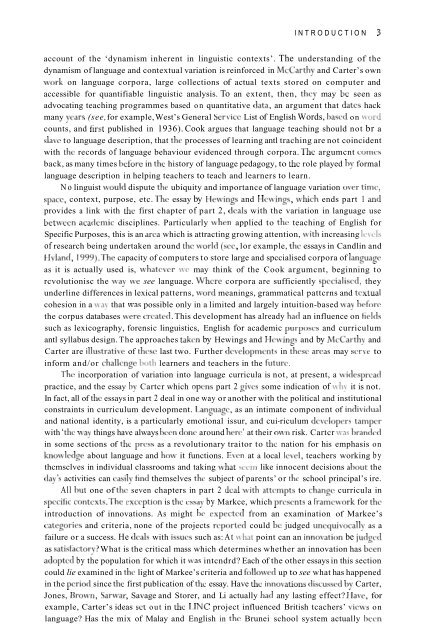Download - Search
Download - Search
Download - Search
You also want an ePaper? Increase the reach of your titles
YUMPU automatically turns print PDFs into web optimized ePapers that Google loves.
INTRODUCTION 3account of the ‘dynamism inherent in linguistic contexts’. The understanding of thedynamism of language and contextual variation is reinforced in McCarthy and Carter’s ownwork on language corpora, large collections of actual texts stored on computer andaccessible for quantifiable linguistic analysis. To an extent, then, thcy may he seen asadvocating teaching programmes based on quantitative data, an argument that dates hackmany ycars (see, for example, West’s General Servicc List of English Words, liascd on kvordcounts, and first published in 1936). Cook argues that language teaching should not br aslave to language description, that thc processes of learning antl traching are not coincidentwith the records of language behaviour evidenced through corpora. The argumcnt comcsback, as many times before in the history of language pedagogy, to the role played liy formallanguage description in helping teachers to teach and learners to learn.No linguist \voulcl dispute the ubiquity and importance of language variation over time,space, context, purpose, etc. The essay by Hewings and Hc\vings, which ends part 1 antlprovides a link with the first chapter of part 2, dcals with the variation in language usebetwccn academic disciplines. Particularly when applied to the teaching of English forSpecific Purposes, this is an area which is attracting growing attention, \vith increasing Ic\-clsof research being undertaken around thc world (see, lor example, the essays in Candlin andFIvlantl, 19YY).The capacity of computers to store large and spccialised corpora of languagt,as it is actually used is, whatcvcr we may think of the Cook argumcnt, beginning torcvolutionisc the way we see language. Where corpora are sufficiently spccialised, theyunderline differences in lexical patterns, word meanings, grammatical pattcrns and tcxtualcohesion in a way that ivas possible only in a limited and largely intuition-based way beforcthe corpus databases ivere created. This development has already hatl an influence on tieltlssuch as lexicography, forensic linguistics, English for academic purposes and curriculumantl syllabus design. The approaches takcn by Hewings and Hclvings and by McCarthy andCarter are illustrative of these last two. Further dcvelopmcnts in thcsc areas may scrve toinform and/or challcnge both learners and teachers in the futurc.The incorporation of variation into language curricula is not, at present, a midesprcatlpractice, and the essay hy Cartcr which opens part 2 gives some indication of why it is not.In fact, all of the essays in part 2 deal in one way or another with the political and institutionalconstraints in curriculum development. Language, as an intimate component of individualand national identity, is a particularly emotional issur, and cui-riculum developers tamperwith ‘the hvay things have always been donc around herc’ at their o\vn risk. Cartcr \vas brantlcdin some sections of the press as a revolutionary traitor to the nation for his emphasis onknowletlge about language and how it functions. Even at a local bel, teachers working bythcmsclves in individual classrooms and taking ivhat seem like innocent decisions ahout theday’s activities can easily tind themselves the subject of parents’ or the school principal’s ire.All but one of thc seven chapters in part 2 deal \vith attcmpts to change curricula inspccific contcxts.The cxccption is the cssay by Markce, which prcsents a framchvork for thcintroduction of innovations. As might hc expected from an examination of Markee’scategorics and criteria, none of the projects reported could be judged uncquivocallq. as afailure or a success. He dcals with issues such as: At \vhat point can an innovation be judgctlas satisfactor?? What is the critical mass which determines whether an innovation has beenadopted by the population for which it was intcndrd? Each of the other essays in this sectioncould lie examined in thc light of Markee’s criteria and follo\vetl up to see what has happenedin the period since the first publication of the essay. Have the innovations discusscd by Carter,Jones, Brown, Sarwar, Savage and Storer, and Li actually hatl any lasting effect? Iiave, forexample, Carter’s ideas set out in the IJNC project influenced British tcachers’ views onlanguage? Has the mix of Malay and English in thc Brunei school system actually liccn


